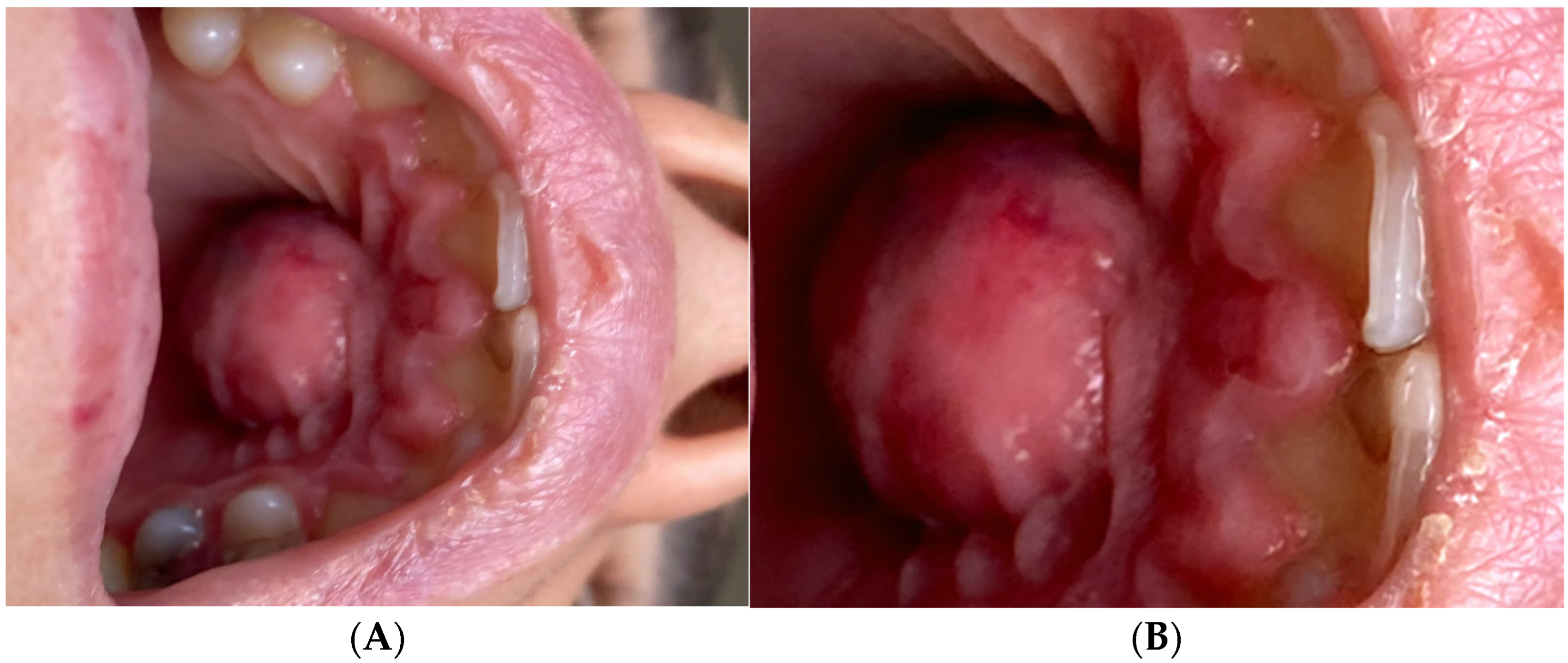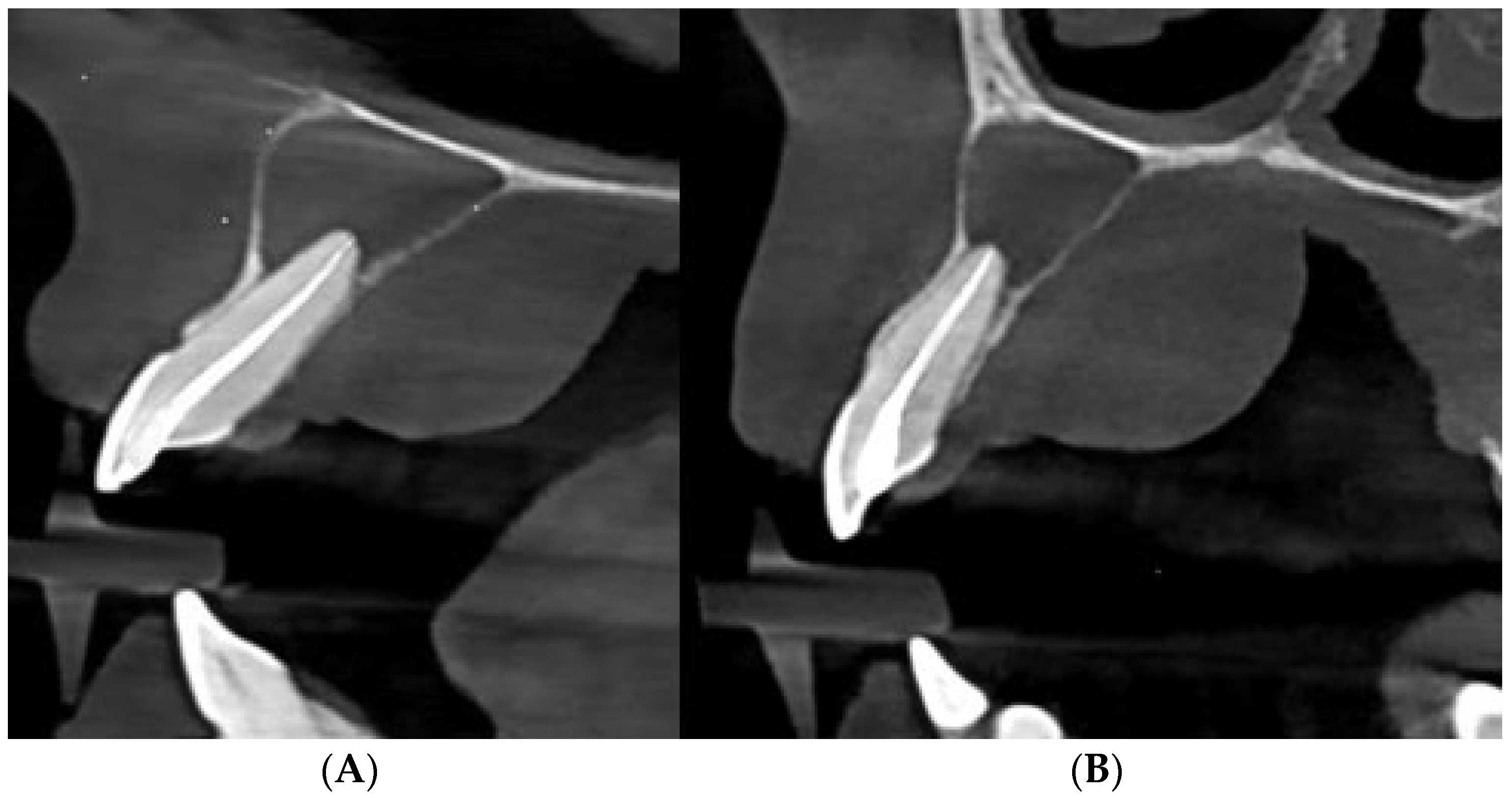Palatal Abscess of Endodontic Origin with Extensive Radiolucency in Maxillary CBCT Imaging
Abstract



Author Contributions
Funding
Institutional Review Board Statement
Informed Consent Statement
Data Availability Statement
Conflicts of Interest
References
- Komabayashi, T.; Jiang, J.; Zhu, Q. Apical infection spreading to adjacent teeth: A case report. Oral Surg. Oral Med. Oral Pathol. Oral Radiol. Endod. 2011, 111, e15–e20. [Google Scholar] [CrossRef] [PubMed]
- Porto, O.C.L.; Silva, B.S.F.; Silva, J.A.; Estrela, C.R.A.; Alencar, A.H.G.; Bueno, M.D.R.; Estrela, C. CBCT assessment of bone thickness in maxillary and mandibular teeth: An anatomic study. J. Appl. Oral Sci. 2020, 28, e20190148. [Google Scholar] [CrossRef] [PubMed]
- Ricucci, D.; Loghin, S.; Gonçalves, L.S.; Rôças, I.N.; Siqueira, J.F., Jr. Histobacteriologic Conditions of the Apical Root Canal System and Periapical Tissues in Teeth Associated with Sinus Tracts. J. Endod. 2018, 44, 405–413. [Google Scholar] [CrossRef] [PubMed]
- Pellecchia, R.; Holmes, C.; Barzani, G.; Sebastiani, F.R. Antimicrobial Therapy and Surgical Management of Odontogenic Infections. In Antimicrobial Resistance—A Global Threat; InTech: London, UK, 2016. [Google Scholar] [CrossRef]
- Teoh, L.; Cheung, M.C.; Dashper, S.G.; James, R.; McCullough, M. Oral Antibiotic for Empirical Management of Acute Dentoalveolar Infections—A Systematic Review. Antibiotics 2021, 10, 240. [Google Scholar] [CrossRef] [PubMed]
- Böttger, S.; Lautenbacher, K.; Domann, E.; Howaldt, H.-P.; Attia, S.; Streckbein, P.; Wilbrand, J.-F. Indication for an additional postoperative antibiotic treatment after surgical incision of serious odontogenic abscesses. J. Craniomaxillofac. Surg. 2020, 48, 229–234. [Google Scholar] [CrossRef] [PubMed]
- Arnold, M.; Ricucci, D.; Siqueira, J.F., Jr. Infection in a Complex Network of Apical Ramifications as the Cause of Persistent Apical Periodontitis: A Case Report. J. Endod. 2013, 39, 1179–1184. [Google Scholar] [CrossRef] [PubMed]
- Karamifar, K.; Tondari, A.; Saghiri, M.A. Endodontic Periapical Lesion: An Overview on the Etiology, Diagnosis and Cur-rent Treatment Modalities. Eur. Endod. J. 2020, 5, 54–67. [Google Scholar] [CrossRef] [PubMed]
- Torabinejad, M.; Corr, R.; Handysides, R.; Shabahang, S. Outcomes of Nonsurgical Retreatment and Endodontic Surgery: A Systematic Review. J. Endod. 2009, 35, 930–937. [Google Scholar] [CrossRef] [PubMed]
- Mejia, J.; Donado, J.; Basrani, B. Active Nonsurgical Decompression of Large Periapical Lesions—3 Case Reports. J. Can. Dent. Assoc. 2004, 70, 691–694. [Google Scholar] [PubMed]
- Houston, G.D.; Brown, F.H. Differential diagnosis of the palatal mass. Compendium 1993, 14, 1222–1224. [Google Scholar] [PubMed]
- Evangelista, K.; de Faria Vasconcelos, K.; Teodoro, A.B.; Cavalcanti, M.G.P.; de Mendonça, E.F.; Watanabe, S.; Silva, M.A.G. Malignant tumours mimicking periapical lesions: A report of three cases and literature review. Aust. Endod. J. 2022, 48, 515–521. [Google Scholar] [CrossRef] [PubMed]
- Asai, S.; Nakamura, S.; Kuribayashi, A.; Sakamoto, J.; Yoshino, N.; Kurabayashi, T. Effective combination of 3 imaging modalities in differentiating between malignant and benign palatal lesions. Oral Surg. Oral Med. Oral Pathol. Oral Radiol. 2021, 131, 256–264. [Google Scholar] [CrossRef] [PubMed]
- Marian, D.; Popovici, R.A.; Olariu, I.; Pitic (Cot), D.E.; Marta, M.-M.; Veja (Ilyes), I. Patterns and Practices in the Use of En-dodontic Materials: Insights from Romanian Dental Practices. Appl. Sci. 2025, 15, 1272. [Google Scholar] [CrossRef]
- Saini, A.; Nangia, D.; Sharma, S.; Kumar, V.; Chawla, A.; Logani, A.; Upadhyay, A.D. Outcome and associated predictors for non-surgical management of large cyst-like periapical lesions: A CBCT-based prospective cohort study. Int. Endod. J. 2023, 56, 146–163. [Google Scholar] [CrossRef] [PubMed]
- Mosquera-Barreiro, C.; Ruíz-Piñón, M.; Sans, F.A.; Nagendrababu, V.; Vinothkumar, T.S.; Martín-González, J.; Mar-tín-Biedma, B.; Castelo-Baz, P. Predictors of periapical bone healing associated with teeth having large periapical lesions following nonsurgical root canal treatment or retreatment: A cone beam computed tomography-based retrospective study. Int. Endod. J. 2024, 57, 23–36. [Google Scholar] [CrossRef] [PubMed]
- Mazzi-Chaves, J.F.; Camargo, R.V.; Borges, A.F.; Silva, R.G.; Pauwels, R.; Silva-Sousa, Y.T.C.; Sousa-Neto, M.D. Cone-beam computed tomography in endodontics—State of the art. Curr. Oral Health Rep. 2021, 8, 9–22. [Google Scholar] [CrossRef]
- Patil, S.; Prasad, B.K.; Shashikala, K. Cone beam computed tomography: Adding three dimensions to endodontics. Int. Dent. Med. J. Adv. Res. 2015, 1, 1–6. [Google Scholar] [CrossRef]
- Alshomrani, F. Cone-Beam Computed Tomography (CBCT)-Based Diagnosis of Dental Bone Defects. Diagnostics 2024, 14, 1404. [Google Scholar] [CrossRef] [PubMed]
- Xia, Z.B.; Ren, J.; Chen, J.X.; Wei, Y.; Yan, Y.; Cao, L.J. An upper left lateral incisor with double roots and double root canals: A case report. Medicine 2025, 104, e42815. [Google Scholar] [CrossRef] [PubMed]
- Meto, A.; Halilaj, G. The Integration of Cone Beam Computed Tomography, Artificial Intelligence, Augmented Reality, and Virtual Reality in Dental Diagnostics, Surgical Planning, and Education: A Narrative Review. Appl. Sci. 2025, 15, 6308. [Google Scholar] [CrossRef]
Disclaimer/Publisher’s Note: The statements, opinions and data contained in all publications are solely those of the individual author(s) and contributor(s) and not of MDPI and/or the editor(s). MDPI and/or the editor(s) disclaim responsibility for any injury to people or property resulting from any ideas, methods, instructions or products referred to in the content. |
© 2025 by the authors. Licensee MDPI, Basel, Switzerland. This article is an open access article distributed under the terms and conditions of the Creative Commons Attribution (CC BY) license (https://creativecommons.org/licenses/by/4.0/).
Share and Cite
Marian, D.; Constantin, G.D.; Stana, A.H.; Lile, I.E.; Hajaj, T.; Gag, O.L. Palatal Abscess of Endodontic Origin with Extensive Radiolucency in Maxillary CBCT Imaging. Diagnostics 2025, 15, 2195. https://doi.org/10.3390/diagnostics15172195
Marian D, Constantin GD, Stana AH, Lile IE, Hajaj T, Gag OL. Palatal Abscess of Endodontic Origin with Extensive Radiolucency in Maxillary CBCT Imaging. Diagnostics. 2025; 15(17):2195. https://doi.org/10.3390/diagnostics15172195
Chicago/Turabian StyleMarian, Diana, George Dumitru Constantin, Ademir Horia Stana, Ioana Elena Lile, Tareq Hajaj, and Otilia Lavinia Gag (Stana). 2025. "Palatal Abscess of Endodontic Origin with Extensive Radiolucency in Maxillary CBCT Imaging" Diagnostics 15, no. 17: 2195. https://doi.org/10.3390/diagnostics15172195
APA StyleMarian, D., Constantin, G. D., Stana, A. H., Lile, I. E., Hajaj, T., & Gag, O. L. (2025). Palatal Abscess of Endodontic Origin with Extensive Radiolucency in Maxillary CBCT Imaging. Diagnostics, 15(17), 2195. https://doi.org/10.3390/diagnostics15172195






